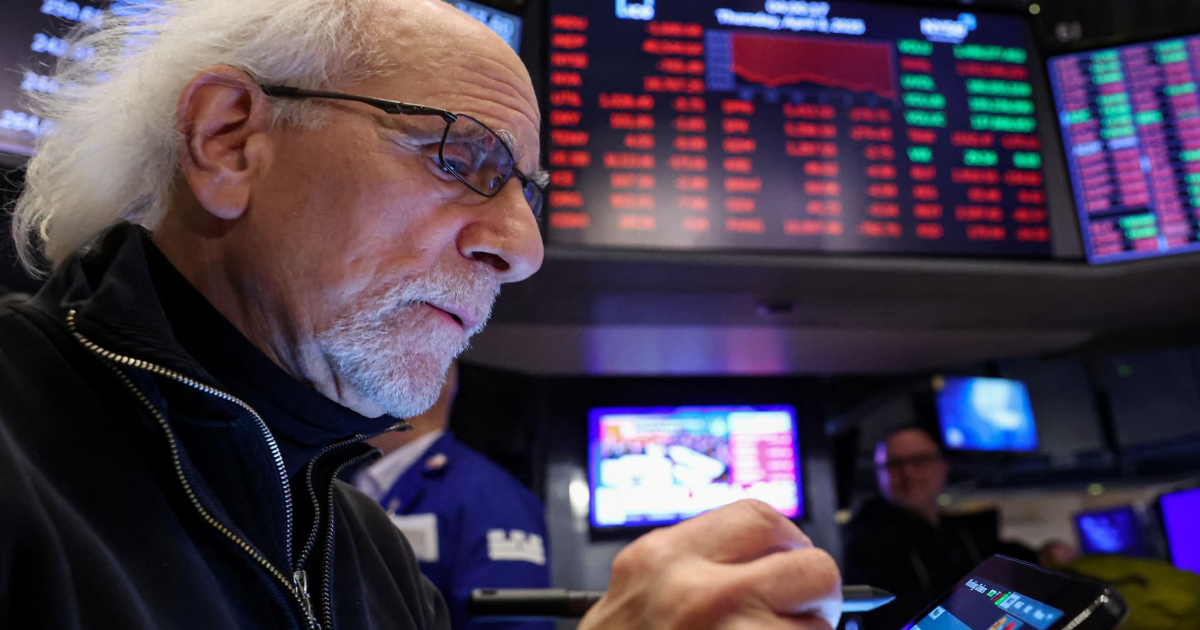Volatility index spikes to highest level since August 2024
The CBOE Volatility Index, known as the Vix, jumped more than 9 points to 39.60 Friday morning. This marked the index’s highest level since the yen carry trade unwinding in August 2024.
The Vix is commonly referred to as “Wall Street’s fear gauge.” It measures future expectations of volatility through S&P 500 stock options.
Stock chart icon
CBOE Volatility Index on Friday
The 10-year Treasury yield fell sharply again on Friday, breaking below the 4% level.
Shortly after 7 a.m. ET, the benchmark Treasury yield was down 17 basis points to 3.882%. A basis point is equal to 0.01 percentage points. Bond prices move opposite of yields.
Stock chart icon
The 10-year Treasury yield fell below 4% on Friday.
The rally for bonds could be a sign that investors who are selling stocks are shifting their money to assets that are traditionally safer.
— Jesse Pound
China’s finance ministry on Friday said it will impose a 34% tariff on all goods imported from the U.S. starting on April 10 in the wake of duties imposed by U.S. President Donald Trump’s administration earlier this week, according to state news outlet Xinhua.
The news sent U.S. stock futures tumbling to their session lows.
— Ruxandra Iordache
Europe’s Stoxx 600 index was 1.67% lower at 9:13 a.m. U.K. time, on track for a third straight day of sharp losses.
Banking stocks dropped 5.7%, while mining stocks lost 3.7%. The food and beverage sector bucked the trend to jump 1.1%.
Germany’s DAX index was last down 1.74%, while the U.K.’s FTSE 100 and France’s CAC 40 were both around 1.3% lower.
Stock chart icon
Stoxx 600 index.
After Thursday’s steep sell-off, the three major indexes are on track to finish the week squarely in the red.
The Nasdaq Composite and S&P 500 have tumbled 4.5% and 3.3%, respectively, week to date. Both the Nasdaq and S&P 500 are tracking for their worst weekly performances since September 2024 and sixth negative week of the last seven.
The Dow has slid 2.5% this week.
— Alex Harring
When markets get agitated, investors flee for what they know: snacks, groceries and utilities.
Consumer staples and utilities, traditionally defensive corners of the market, are on pace for positive weeks. Staples are up 2.4% week to date, while utilities are on track for a 1.2% advance.
Big winners among consumer staples include potato producer Lamb Weston, which surged 10% on Thursday and is on track for a 10% pop this week. The company caught a tailwind from fiscal third-quarter results that surpassed consensus estimates, per StreetAccount. The top bands of its full-year earnings and revenue guidance also topped the Street’s estimates.
Stock chart icon
One-day chart for Lamb Weston
Dollar General, which is on track for a 9.7% week-to-date jump, and supermarket giant Kroger, up 6% this week, are also big winners in the staples category.
Among utilities, Exelon Corporation is the top performer this week, up 5.6% thus far. American Water Works and Duke Energy follow, both on pace to rise 3.9% during the period.
To sweeten the deal for investors, not only did these names survive Thursday’s sell-off, but they are also all dividend payers. Consider that Exelon and Duke offer dividend yields in excess of 3%, while Dollar General and Lamb Weston have dividend yields that top 2%.
— Darla Mercado
Shares of GameStop climbed nearly 3% in extended trading after a regulatory filing revealed CEO Ryan Cohen bought more shares of his video game retailer.
Cohen increased his stake to 37.3 million shares from 36.8 million shares. The meme stock dropped 7% Thursday amid a broad market sell-off triggered by Trump’s tariff rollout.
GameStop recently raised $1.3 billion through the sale of convertible senior notes due in 2030 to buy bitcoin. The stock is down more than 32% this year.
— Yun Li
The odds of a global recession will rise to 60% if President Donald Trump’s tariff plan goes forward as initially presented, according to Bruce Kasman, chief economist at JPMorgan.
Kasman previously had the likelihood set at 40%.
“We are not making immediate changes to our forecasts and want to see the initial implementation and negotiation process that takes hold. However, we view the full implementation of announced policies as a substantial macroeconomic shock not currently incorporated in our forecasts,” he wrote to clients in a Thursday note. “We thus emphasize that these policies, if sustained, would likely push the [U.S.] and possibly global economy into recession this year.”
— Alex Harring
Dow futures were down shortly after 6 p.m. ET.
Futures tied to the blue-chip index and the broad S&P 500 both slipped 0.1% shortly after 6 p.m. ET. Nasdaq 100 futures sat near flat.
— Alex Harring

